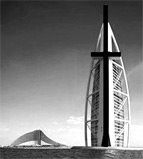Several features of the hotel required complex engineering feats to achieve. The hotel rests on an artificial island constructed 280 meters offshore. To secure a foundation, the builders drove 230 40-meter long concrete piles into the sand.
Engineers created a surface layer of large rocks, which is circled with a concrete honey-comb pattern, which serves to protect the foundation from erosion. It took three years to reclaim the land from the sea, but less than three years to construct the building itself. The building contains over 70,000 cubic meters of concrete and 9,000 tons of steel.

Inside the building, the atrium is 180 meters (590 ft) tall.
Burj Al Arab characterizes itself as the world's only "7-star" property, a designation considered by travel professionals to be hyperbole. All major travel guides and hotel rating systems have a 5-star maximum, which some hotels attempt to out-do by ascribing themselves "6-star" status. Yet according to the Burj Al Arab's official site, the hotel is a "5-star deluxe hotel". It is the world's tallest structure with a membrane facade and the world's tallest hotel (not including buildings with mixed use) and was the first 5-star hotel to surpass 1,000 ft (305 m) in height.





It is managed by the Jumeirah Group. Despite its size, the Burj Al Arab holds only 28 double-story floors which accommodate 202 bedroom suites. The smallest suite occupies an area of 169 square meters (1,819 sq ft), the largest covers 780 square meters (8,396 sq ft). It is one of the most expensive hotels in the world. The cost of staying in a suite begins at $1,000 per night; the Royal Suite is the most expensive, at $28,000 per night.
Suites feature design details that juxtapose east and west. White Tuscan columns and a spiral staircase covered in marble with a wrought-iron gold leaf railing show influence from classicism and art nouveau. Spa-like bathrooms are accented by mosaic tile patterns on the floors and walls, with Arabian-influenced geometries, which are also found elsewhere in the building.





























Read more!
